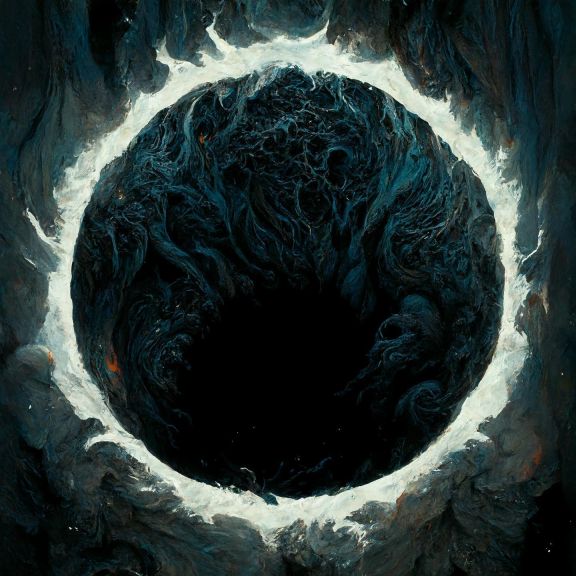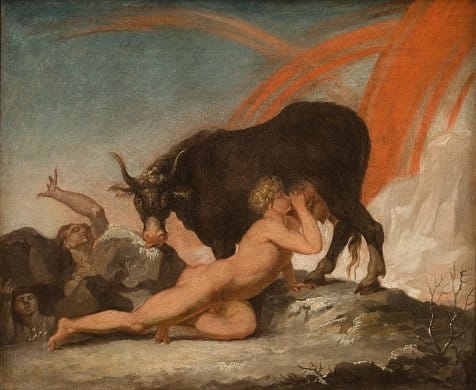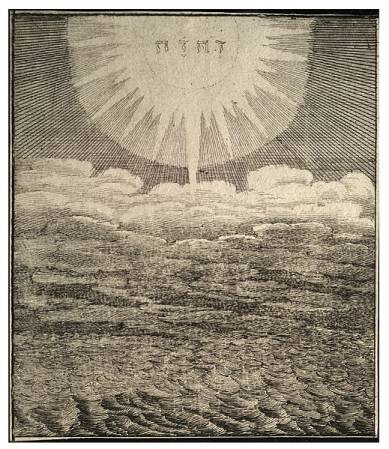Step into the abyss that is Ginnungagap, the yawning void that existed before the cosmos began. In this post, I’ll take you deep into this mysterious abyss and explore its fascinating origins, as well as its lasting impact on Norse cosmology.
The term Ginnungagap is usually translated as “gaping abyss” or “yawning void”. As the genesis of all existence, it is mentioned in several poems from the Poetic Edda. It is also prominent in the beginning of the Gylfaginning, part of Snorri Sturluson’s Prose Edda. But what is Ginnungagap, and how does it fit into the Norse creation story? Let’s dive in and find out.
Ginnungagap and Creation: The Forces of Fire and Ice

In the beginning, Ginnungagap was the vast abyss that had always existed, lying between the fiery realm of Muspelheim and the frosty realm of Niflheim. Picture the intense contrast between these realms: one filled with searing heat, and the other cloaked in frost and darkness. When the elements of fire and ice met in Ginnungagap, the stage was set for the emergence of life and the creation of the cosmos.
This encounter of fire and ice in Ginnungagap is described vividly in the Gylfaginning ch. four.
It was Time’s morning,
When there nothing was;
Nor sand, nor sea,
Nor cooling billows.
Earth there was not,
Nor heaven above.
The Ginungagap was,
But grass nowhere.
The Clash of Muspelheim and Niflheim
Out there, in the void, the two primordial realms of Muspelheim and Niflheim grew ever closer. Finally, as described in Gylfaginning, the two realms came together, and that mix resulted in the creation of life.
“All that part of Ginnungagap that turns toward the north was filled with thick and heavy ice and rime, and everywhere within were drizzling rains and gusts. But the south part of Ginungagap was lighted up by the glowing sparks that flew out of Muspelheim.”
“As cold and all things grim proceeded from Niflheim, so that which bordered on Muspelheim was hot and bright, and Ginungagap was as warm and mild as windless air. And when the heated blasts from Muspelheim met the rime, so that it melted into drops, then, by the might of him who sent the heat, the drops quickened into life and took the likeness of a man, who got the name Ymir. But the Frost-giants call him Aurgelmer.”
The Emergence of Life: Ymir and Audhumla

Out of Ginnungagap, Ymir, the primordial giant, was born. He played a crucial role in Norse mythology and symbolized the chaotic forces that the gods would later struggle to tame. Alongside Ymir emerged Audhumla, the cosmic cow, whose nourishing rivers provided sustenance for the early cosmos.
As described in the Eddic poem Völuspá, before the cosmos existed, “there was no sand, nor sea, nor cool waves, no earth nor sky nor grass there, only Ginnungagap.” Ymir and Audhumla’s birth triggered a turning point in the creation narrative, unleashing the chaotic forces that would eventually shape the world we know.
Ginnungagap’s Role in Cosmology and Symbolism
The concept of Ginnungagap held great significance in Norse thought. In many ways, it represented the duality of creation and destruction, as well as the ongoing struggle between order and chaos. The Norse and other Germanic peoples saw this chaos-cosmos split as an opposition between the innangard and the utangard. Indeed as the opposition between orderly and civilized and the wild and anarchic respectively.
Ginnungagap, in its perfect silence and darkness, bears a striking resemblance to the primordial voids found in other mythologies around the world, such as the Judeo-Christian Genesis account. This opposition between the well-ordered cosmos and the lawless chaos surrounding it is perhaps one of the most common themes in religion and human consciousness.
Comparing Ginnungagap with the Greek Creation from Chaos
In both Norse and Greek mythologies, the origin of the cosmos is rooted in a primordial void, Ginnungagap and Chaos respectively. While both serve as the foundation for the creation of the universe, the creation process in each mythology is distinct.
In Norse mythology, the interaction between the realms of fire (Muspelheim) and ice (Niflheim) within Ginnungagap led to the birth of life, including the primordial giant Ymir and the cosmic cow Audhumla. The gods Odin, Vili and Ve used Ymir’s body to form the Norse cosmos and particularly Midgard.

In contrast, Greek mythology presents the emergence of primordial deities directly from Chaos itself. Gaia (Earth) was the first to arise, followed by Tartarus (the abyss beneath the Earth) and Eros (Love). These primordial gods represent the fundamental forces and elements that would later give birth to the Titans and Olympian gods.
This focus on primordial deities emerging from Chaos highlights the Greek perspective on the origins of life and the nature of existence. It provides a unique contrast to the elemental interactions that shape the Norse creation story within Ginnungagap.
Ginnungagap as a Geographic Location
In the early 15th century, some Scandinavian cartographers sought to identify Ginnungagap as a real geographic location, inspired by the Norse creation myth. According to a fragment from the Old Norse 15th-century encyclopedic text called Gripla (Little Compendium), Ginnungagap is situated between Greenland and Vinland. This text suggests that the vast expanse of Ginnungagap separates Vinland and Greenland, flowing from the sea called Mare oceanum and encircling the earth.
Interestingly, a scholion in a 15th-century manuscript of Adam of Bremen’s Gesta Hammaburgensis Ecclesiae Pontificum also refers to Ghimmendegop as the Norse word for the abyss in the far north.
Centuries later, in the 17th century, Icelandic bishop Guðbrandur Thorlaksson used the name Ginnungegap to refer to a body of water. This was possibly the narrow Davis Strait, separating the southern tip of Greenland from Estotelandia, pars America extrema, which is likely Baffin Island. These historical connections showcase how Norse cartographers of the time seemingly attempted to integrate their mythical beliefs with their real-world experiences.
Moreover, this was four hundred years after the Viking Age supposedly ended. While Christianity certainly replaced Norse paganism, it was a slow-moving process and vestiges of the old beliefs likely survived for a long time.
Last Thoughts on Journeying Into the Void
Journeying through Ginnungagap and delving into its role in Norse mythology, we uncover the origins of fire and ice interacting. Indeed the emergence of first life from the void, and the potent symbolism of the primordial abyss.
In Norse mythology, Ginnungagap represents both the beginning and the end, the eternal space encompassing all creation. Interestingly, this concept shares similarities with our current belief in the “Big Bang” as the starting point of creation within the cosmic void.
So, when you gaze at the vastness of the night sky or marvel at a snow-covered landscape, remember the tale of Ginnungagap. The formidable forces of creation and destruction persistently shape our world and our understanding of it, even today.
FAQs about Ginnungagap
In Norse mythology, Ginnungagap is the primordial void or yawning abyss existing before the cosmos’ creation. It separates the realms of fire, Muspelheim, and ice, Niflheim, where their interaction set the stage for all later life.
Ginnungagap enabled the meeting of fire from Muspelheim and ice from Niflheim. This convergence birthed Ymir, the primordial giant, and Audhumla, the cosmic cow, marking the Norse creation story’s beginning.
Ginnungagap represents the eternal struggle between order and chaos, and the duality of creation and destruction. It symbolizes the balance necessary for maintaining harmony in the cosmos and our lives.
Ginnungagap resembles primordial voids in other mythologies, such as the Judeo-Christian Genesis account. This juxtaposition of a well-ordered cosmos and surrounding lawless chaos is a recurring theme in religion and human consciousness.
In Norse mythology, Ymir, the primordial giant, and Audhumla, the cosmic cow, emerged from Ginnungagap and played pivotal roles. Ymir represent the chaotic forces that gods would tame, while Audhumla’s sustaining rivers of milk nourished the early cosmos.
During Ragnarok, the “Twilight of the Gods,” the cosmos collapses back into Ginnungagap. The void returns to its all-encompassing state, holding the potential for new creation and destruction cycles.
Featured Image Credit: aiartjournal via Instagram
